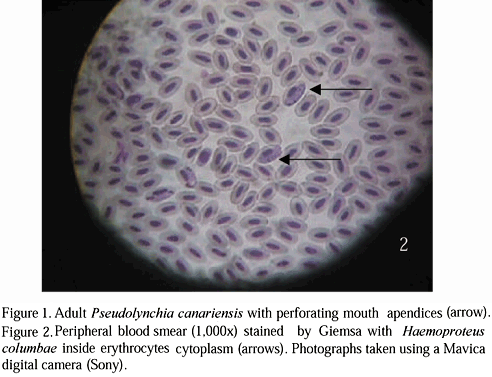Resumo
Relata-se um surto de malária por Haemoproteus columbae em pombos-correio (Columba livia), caracterizado por um quadro agudo com mortalidade de 3% ao dia em aves de aspecto saudável ou crônico com prostração e fraqueza. O exame clínico das aves doentes evidenciou sinusite e conjuntivite e à necropsia traqueíte hemorrágica, aerossaculite, esplenomegalia, nefromegalia e hepatomegalia com hemorragias. O díptero hematófago da família Hippoboscidae Pseudolynchia canariensis foi encontrado inserido entre as penas dos indivíduos. Esfregaços de sangue periférico e cardíaco e impressões de baço e fígado corados por Giemsa permitiram a visualização de inclusões intraeritrocitárias características de Haemoproteus columbae
Pombo-correio
a15v53n3
COMMUNICATION
[Comunicação]
An outbreak of malaria by Haemoproteus columbae in pigeons
[Surto de malária por Haemoproteus columbae em pombos]
J.S. Resende1, N.R.S. Martins1, M.A. Jorge2
1Escola de Veterinária da UFMG
Caixa Postal 567
30123-970 - Belo Horizonte, MG
2EMBRAPA/EPAMIG
Recebido para publicação em 15 de setembro de 2000.
e-mail: rodrigo@vet.ufmg.br
Malaria by Haemoproteus columbae is an usually chronic condition of pigeons and doves, resulting in low mortality and few clinical signs. The protozoan is transmitted by biting dipterans of Hippoboscidae (louse flies) and Ceratopogonidae (biting midges) families, with life cycle including sporogony within one week in the former and one or two weeks in the latter. Schizonts in pulmonary vascular endothelium produce merozoites which invade erythrocytes to form macro and microgametocytes. At least two schizogonies are required for the production of gametes in erythocytes. A second generation of megaloschizonts is described in cardiac and skeletal muscles for Haemoproteus meleagridis. Transmission occurs after sequential biting of vectors on infected birds with sexual stages in erythrocytes for ingestion of blood (Kemp, 1978; van der Heyden, 1996; Springer, 1997). An outbreak of disease characterized by rapid death in young well-nourished racing pigeons (Columba livia) is described. Birds were brought to the laboratory as a result of high mortality in the flock. The pigeons were kept in a single aviary large enough to accommodate 3,000 pigeons. As far as provision of adequate nutrition is concerned, birds were properly managed. However, relating to quarantine, no measures were taken prior to introducing birds into the aviary. Young pigeons, in apparent good health were most usually infected, developing fulminating disease with deaths reaching 100 birds per day in the flock (3% per day), although prostration was observed in some individuals which had conjunctivitis and sinusitis. Birds were primarily examined for ectoparasites and the hematophagous hippoboscid dipterous insect pigeon fly Pseudolynchia canariensis (Figure 1) was detected amidst the body feathers. Birds were necropsied and the relevant features observed were sinusitis, conjunctivitis, hemorrhagic tracheitis, aerossaculitis, hepatomegaly with hemorrhagies, splenomegaly, nephromegaly and paleness. Other relevant ectoparasites were detected, such as Columbicula columbae. Peripheral and cardiac blood and liver and spleen impression smears were stained by Giemsa and large cytoplasmic inclusions, occupying half of the cytoplasm of erythrocytes, were observed at 1,000 magnification light microscopy (Figure 2). The characteristics of the inclusions, typical of Haemoproteus columbae (Plasmodiidae), suggested that diagnosis. Considering the severity and spectrum of clinical findings and lesions observed at the outbreak, it is suspected that other pathogens may be associated with the disease, such as chlamydiosis (oculo-respiratory involvement) and remain to be elucidated. The involvement of Newcastle disease virus was investigated by inoculating 10-day of incubation embryonating SPF eggs via allantoic cavity and 6 week-old SPF chickens without signs of virus isolation or any relevant findings in embryos or chickens. Birds were serologically negative to Salmonella pullorum. The outbreak was controlled by eliminating the arthropod vector with the application of an insecticide (pyrethrum insecticide Deltamethrin) and the medication of the pigeons for malaria was recommended with Primaquin. The treatment of eventual concomitant bacterial infections was suggested with a large spectrum antibiotic such as Norfloxacin. Additional recommendations included the quarantine and medication of birds prior to introduction into the flock.
Keywords: Racing pigeon, Haemoproteus columbae
RESUMO
Relata-se um surto de malária por Haemoproteus columbae em pombos-correio (Columba livia), caracterizado por um quadro agudo com mortalidade de 3% ao dia em aves de aspecto saudável ou crônico com prostração e fraqueza. O exame clínico das aves doentes evidenciou sinusite e conjuntivite e à necropsia traqueíte hemorrágica, aerossaculite, esplenomegalia, nefromegalia e hepatomegalia com hemorragias. O díptero hematófago da família Hippoboscidae Pseudolynchia canariensis foi encontrado inserido entre as penas dos indivíduos. Esfregaços de sangue periférico e cardíaco e impressões de baço e fígado corados por Giemsa permitiram a visualização de inclusões intraeritrocitárias características de Haemoproteus columbae.
Palavras-chave: Pombo-correio, Haemoproteus columbae
- KEMP, R.L. Haemoproteus. In: Hofstad, M.S. et al. (Ed). Diseases of poultry, 7.ed. Ames: Iowa State University Press, 1978. p.824-825.
- SPRINGER, W.T. Other blood and tissue protozoa. In: Calnek, B.W. et al. (Ed). Diseases of poultry, 9.ed. Ames: Iowa State University Press, 1997. p.900-911.
- van der HEYDEN,. Hemoparasites. In Rosskopf, W.J., Woerpel, R.W. (Ed). Diseases of cage and aviary birds, 3.ed. Lea & Febiger, Williams & Wilkins, 1996. p.627-629.
Datas de Publicação
-
Publicação nesta coleção
12 Jun 2002 -
Data do Fascículo
Jun 2001
Histórico
-
Recebido
15 Set 2000



